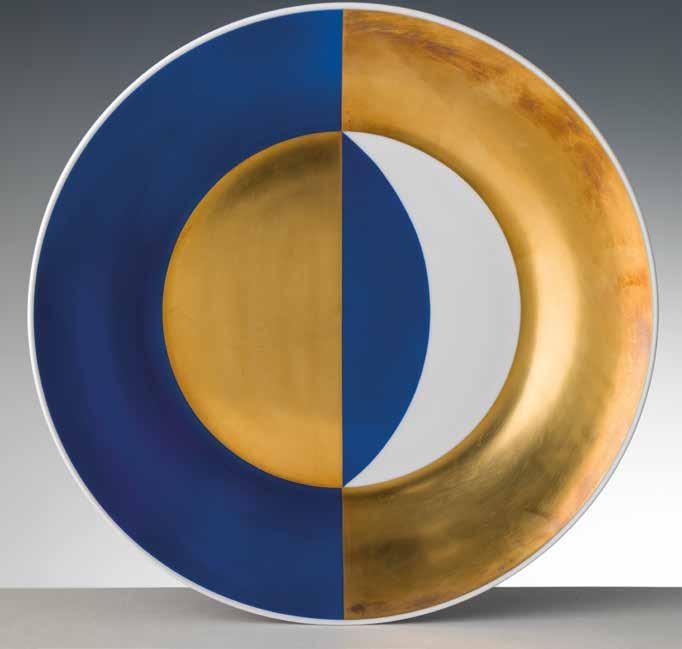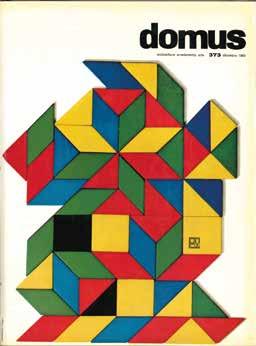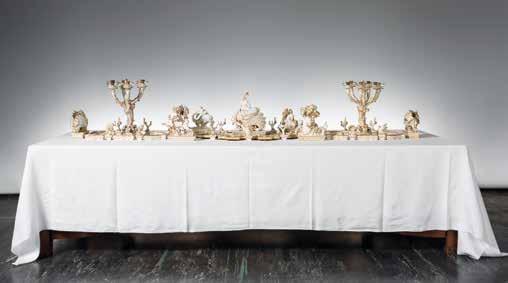



 BLUE FLUO ISSUE • n°38 • 2024
BLUE FLUO ISSUE • n°38 • 2024





 BLUE FLUO ISSUE • n°38 • 2024
BLUE FLUO ISSUE • n°38 • 2024
Discovering the beauty and innovation of the inventor of Made in Italy through his iconic ceramics, a blend of art and design
by Micaela Zucconi
Villa Planchard plate designed by architect and designer Gio Ponti (Milan, 1891- Milan, 1979), Società Ceramica Richard-Ginori, 1957. Richard-Ginori museum at the Doccia factory in Sesto Fiorentino
Some covers of Domus and Stile magazines, edited by Gio Ponti and founded by him in 1928 and 1941 respectively (and reanimated from 1948 to 1979). They provided the architect with a means of promoting his concept of modernity
“L

earn the things made with the hands. Nothing that was not first in the hands”, said Gio Ponti (1891-1979). The quotation brings to mind his iconic hands with flowers, almost a symbol of the thought processes of the architect, sculptor and designer. Ponti is regarded as one of the most important exponents of Italian style through his design work and his influence as editor of magazines like Domus and Stile, the network of relationships with artists, industrialists and artisans and his participation in exhibitions and shows in Italy and abroad promoting Made in Italy manufacture and design. In Faenza, the MIC (Museo Internazionale delle Ceramiche) dedicated to this eclectic genius has dedicated a retrospective of his career (until 13 October). “Gio Ponti. Ceramics 1922-1967. Over 200 works by the inventor of Made in Italy” depicts the maestro’s output in fourteen sections, with over 200 pieces including objects in ceramic and glass as well as furniture and drawings covering a period between 1922 and 1978, relating to his vision of a new, modern way of living. It’s not possible to talk about Gio Ponti without mentioning a crucial period in his career spent at the Richard Ginori factory, where he went to work immediately after graduating. Between 1921 and 1922 he was already beginning to put his ideas into practice, exploring classic Etruscan and Roman tradition and artistically-inspired artisanality, adapting them to modern tastes and the then-popular dictates of Art Deco. Ponti followed every aspect in the lifetime of his products, from conception to promotion and sales, opening the way for the development of Italian design. During his ten years as artistic director he designed around 200 models and 350 decorations.


It was through this high-quality series production that, in the words of the Ginori museum website, “He developed his initial thinking about the industry, decorative art and domestic furnishings, not just ceramics”. In 1933 he left the factory – although he remained in contact with it –and began his professional ascent in the world of the arts, design and architecture. His versatile creative talent ranged from ceramics - also for other companies in the industry like Pozzi and Gabbianelli) – to wallpaper with Delmonte, glass with Venini, ocean liners, skyscrapers like the Pirelli building in Milan and furniture and complements designed for the largest furnishing companies, including Cassina and Fontana Arte. His ceramic vases are sculptural pieces that are still highly sought-after, as



Richard-Ginori, 1926-40, Museo Internazionale di Ceramica in Faenza. Gio Ponti and Italo Griselli, La Terra Promessa sculpture, Doccia, Soc. Ceramica RichardGinori, 1927-30, MIC. To side, Gio Ponti, Alato cup, Soc. Ceramica
Richard-Ginori, 1927, Museo Ginori, Sesto Fiorentino. Gio Ponti, two examples of Mano Fiorita, Soc. Ceramica Richard-Ginori, 1935, Museo Ginori

the prices they fetch at auction clearly show. His vision has influenced his successors, a list that includes Alessandro Mendini, Ettore Sottsass and contemporary talent like POL Polloniato, Diego Cibelli, Bertozzi&Casoni and Andrea Salvatori.
Curated by Stefania Cretella, the exhibition forms part of the programme mounted by the museum to highlight the people and manufacturers who are responsible for the success of Made in Italy ceramics. A crucial role has been played by the partnership of the Fondazione Museo Archivio Richard Ginori of the Doccia factory in Sesto Fiorentino and Gio Ponti Archives, which also collaborated in the film “Amare Gio Ponti”, directed by Francesca Molteni and produced by Muse Factory of Projects.
www.micfaenza.org







Cibau, Il Poeta, 1926-1930, Museo
Internazionale delle Ceramiche, Faenza. Centre, left, Gio Ponti, Vaso Agata, c. 1925, Rosignano Marittimo (LI) Raffaello Pernici. To side, Gio Ponti, Vaso Prospettica, Soc. Ceramica
Richard-Ginori, 1925, Museo Ginori. Gio Ponti and Tomaso Buzzi, elaborate table centrepiece for Italian embassies, 41 elementi, 1925-27, Soc. Ceramica
Richard-Ginori, Fondazione Museo
Archivio Richard Ginori at the Doccia factory
